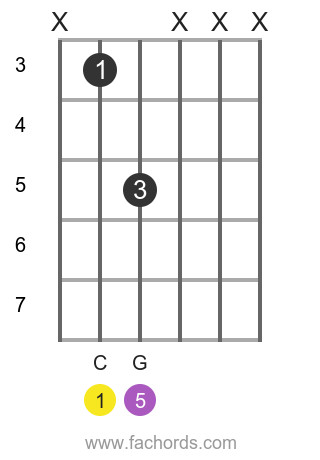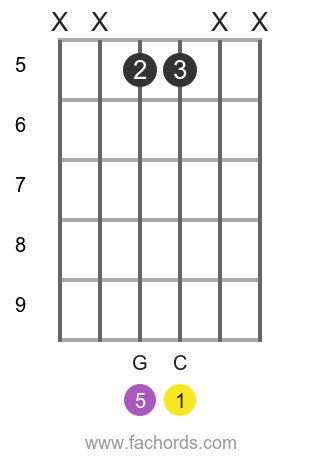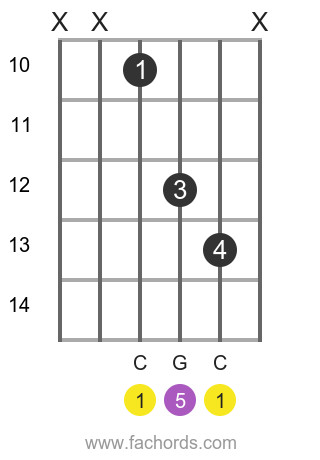Welcome to your comprehensive guide on the C5 Guitar Chord, a foundational element in the world of power chords. If you’re looking to inject raw energy into your guitar playing, you’ve come to the right place. The C5 chord, at its core, is a power chord – a simplified chord voicing known for its robust and driving sound. Comprising just two notes, the root (C) and the fifth (G), the C5 is lean, powerful, and incredibly versatile.
Power chords, including the C5, are built using the musical intervals of the 1st (root) and 5th (perfect fifth). Understanding intervals is key to grasping how chords are constructed. If music theory feels like a mystery, we encourage you to explore our detailed fretboard intervals tutorial and guitar music theory tutorial. These resources will demystify the building blocks of music and enhance your understanding of chords like the C5.
The C5 power chord is synonymous with genres like rock, punk, and heavy metal. Its powerful, uncluttered sound is particularly effective when played on an electric guitar with overdrive or distortion, creating the signature crunch that defines these musical styles. To delve deeper into the world of power chords and their application, our dedicated power chords tutorial offers invaluable insights and techniques.
In this guide, we’ll break down how to play the C5 chord across the guitar fretboard. We’ll utilize chord diagrams and fretboard patterns, visually highlighting the essential notes of the chord. This approach will not only help you learn the shapes but also understand the underlying structure of the C5. Encountering a chord shape you can’t identify? Our interactive chord namer tool is always available to assist in deciphering any chord.
Let’s plug in and explore the dynamic world of the C5 guitar chord, and unlock some seriously powerful musical possibilities!
Decoding the C5 Chord: Notes and Formula
The C5 power chord is defined by its simplicity and strength. Here’s a quick breakdown:
- Notes in a C5 Chord: C, G
- Intervals: Root (1), Perfect Fifth (5)
While technically just two notes, the power of the C5 lies in its harmonic implications and its role in creating driving rhythms and riffs.
The formula for a power chord, including C5, is derived from the major scale but omits the third, resulting in a sound that is neither major nor minor, but powerfully ambiguous:
Power Chord Formula: 1 – 5
This simplified structure is what gives power chords their raw, impactful sound, making them ideal for aggressive and rhythmically focused music.
Visualizing the C5 Chord: Chord Diagrams and Positions
Chord diagrams are essential tools for guitarists. They provide a visual representation of the fretboard, showing you exactly where to place your fingers to play a chord. Remember to check out our guide on how to read chord diagrams if you’re new to using them.
For those who find barre chords challenging, our Bar Chords Tips tutorial offers strategies and exercises to master these essential techniques.
Below, we present multiple positions for playing the C5 chord. Each position offers a slightly different voicing and feel, allowing you to adapt to different musical contexts and find what resonates best with your playing style. For a text-based representation of these diagrams, visit our accessible chords page.
Position 1: The Classic Power Chord Shape (Movable)
 C 5 position 1 guitar chord diagram
C 5 position 1 guitar chord diagram
This is perhaps the most common and recognizable power chord shape. It’s movable, meaning you can slide this shape up and down the neck to play different power chords. The root note is on the 5th string.
Position 2: Another Movable Shape (Root on 6th String)
 C 5 position 2 guitar chord diagram
C 5 position 2 guitar chord diagram
Position 2 offers a variation where the root note is on the 6th string. This is also a movable shape, perfect for riffs and progressions that require a lower root position.
Position 3: Higher Fretboard Voicing (Movable)
 C 5 position 6 guitar chord diagram
C 5 position 6 guitar chord diagram
Moving higher up the fretboard, Position 3 gives you a brighter voicing of the C5 chord. Like the others, it’s movable and useful for adding variation to your chord vocabulary.
Position 4: Extended Range Shape (Movable)
 C 5 position 3 guitar chord diagram
C 5 position 3 guitar chord diagram
Position 4 utilizes a wider finger stretch and incorporates strings further apart. This movable shape offers a fuller sound and is great for rhythm playing.
Position 5: Compact and Efficient (Movable)
 C 5 position 4 guitar chord diagram
C 5 position 4 guitar chord diagram
This position is very compact, using just three adjacent strings. It’s a movable and efficient way to play the C5, especially useful for fast chord changes.
Position 6: Root on the D String (Movable)
 C 5 position 10 guitar chord diagram
C 5 position 10 guitar chord diagram
Position 6 places the root note on the D string (4th string). This movable shape is less common for power chords but offers a unique voicing and can be useful in certain musical contexts.
Position 7: Barre Chord Style C5 (Barre Movable)
 C 5 position 5 guitar chord diagram
C 5 position 5 guitar chord diagram
Position 7 employs a barre chord technique, which can be slightly more challenging but offers a very solid and resonant C5 sound. This movable shape is excellent for powerful strumming and rhythm work.
Explore our all guitar chords library for even more chord variations and shapes. For a handy reference guide, download our Free Guitar Chords Chart Pdf for printable chord diagrams.
Power Chord Progression: C5 and Beyond
The C5 chord is just the beginning. Power chords are incredibly versatile and can be built on any root note. Here are some common power chords to explore, each linked to its dedicated page:
C 5 | D 5 | E 5 | F 5 | G 5 | A 5 | B 5 | C#5 | D#5 | F#5 | G#5 | A#5 | Ab5 | Bb5 | Db5 | Eb5 | Gb5
Understanding the fretboard is key to unlocking your musical potential. The fretboard map below visually represents the notes of the C5 chord across the fretboard. By understanding this map, you can create your own C5 chord voicings and variations anywhere on the neck. Simply locate the root (1) and fifth (5) intervals to construct your C5 power chord.
[Fretboard map image – Text representation below]
0 1 2 3 4 5 6 7 8 9 10 11 12 13 14 15
E - - - - - 5 - - - - - - 5 - - -
B - - - - 1 - - - - - 1 - - - 1 -
G - - 5 - - - - 5 - - - - - 5 - -
D - 1 - - - - 1 - - - - 1 - - - -
A 5 - - - - - - - 5 - - - - - - 5
E - - - - - 5 - - - - - - 5 - - -By exploring these positions and understanding the underlying theory, you’ll master the C5 guitar chord and unlock a powerful tool for rock, punk, and beyond. Keep practicing, and get ready to rock!

